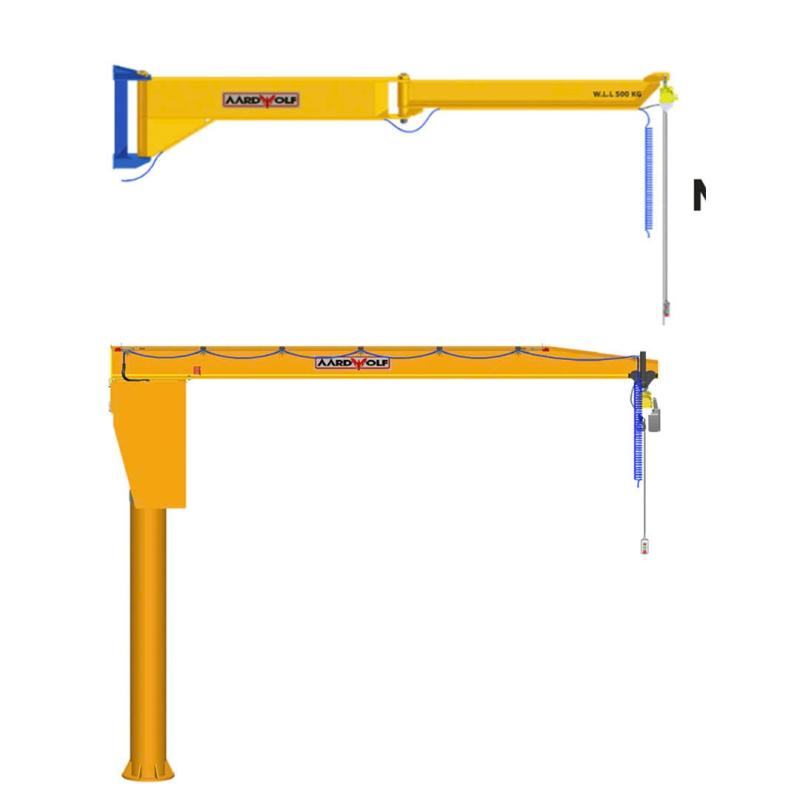



Both are powerful lifting solutions, but they serve distinct purposes depending on the workspace, load capacity, and mobility requirements.
This guide compares the technical features, applications, pros, and cons of jib cranes vs. gantry cranes, helping you determine the right fit for your facility. With real-world examples from Aardwolf—a leading manufacturer of lifting systems—you’ll gain insight into what works best for your operation.
To explore industry-standard options, browse The resolutions of Jib Cranes.
Jib cranes are fixed or semi-fixed lifting systems with a rotating horizontal arm (the jib or boom) that supports a hoist. They are commonly mounted on floors, walls, ceilings, or pillars and are designed for localized, repetitive lifting tasks.
Freestanding Jib Crane: Mounted on concrete foundation; full 360° rotation
Wall Mounted Jib Crane: Attached to a structural wall; rotation of 180°–200°
Ceiling Mounted Jib Crane: Suspended from overhead beams; saves floor space
Articulating Jib Crane: Dual-arm system for maneuvering around obstacles
Pillar Jib Crane: Floor-mounted to a column or fabricated pillar structure
Explore the full breakdown on How to use Jib Cranes efficiently.
Gantry cranes are mobile or fixed cranes supported by two vertical legs and a horizontal beam. They can be either track-mounted or portable with wheels, and are ideal for covering large work areas or lifting loads across wide distances.
Fixed Gantry: Stationary setup for heavy-duty lifting in a defined space
Portable Gantry: Mobile, ideal for maintenance or lightweight loads
Adjustable Height Gantry: Height and span can be changed depending on task
Track-Mounted Gantry: Covers wide facility spaces with high load capacity
| Feature | Jib Cranes | Gantry Cranes |
|---|---|---|
| Mounting Style | Wall, floor, ceiling, pillar | Freestanding with legs |
| Rotation | 180°–360° (depending on type) | Typically limited to linear movement |
| Mobility | Mostly stationary | High (for portable gantry models) |
| Space Requirements | Compact; minimal floor space | Requires more floor clearance |
| Ideal Load Range | 100 kg – 2 tons (model dependent) | 500 kg – 10+ tons (varies by model) |
| Common Applications | Workstations, machine shops, assembly lines | Warehouses, loading docks, outdoor yards |
| Setup Time | Moderate to permanent install | Quick setup (for portable models) |
For more context, see What is the difference between jib vs overhead crane.
Product: Articulated Jib Crane Wall Mounted
Application: Precise part installation in tight engine bay spaces
Result: Reduced labor requirements by 50%, optimized workflow in confined cells
Product: Wall Mounted Jib Crane – 4m-250
Application: Lifting raw metal sheets from racks to cutting tables
Result: Increased lifting cycles per shift by 30%
Product: Aardwolf Portable Gantry Crane (Custom Build)
Application: Handling stone slabs for delivery prep
Result: Flexible lifting across changing outdoor layouts
You need repetitive lifting at fixed workstations
You want minimal floor obstruction
You need a cost-effective and compact solution
Jib cranes excel in focused environments like:
CNC loading/unloading
Molding operations
Small fabrication cells
Tool and die handling
You need mobility across work zones
You require higher load capacity
You have no structural support for mounting
Gantry cranes are ideal for:
Moving goods in large warehouses
Temporary lift setups
Outdoor applications without ceiling structures
Typical jib cranes: Up to 2 tons
Gantry cranes: Up to 10+ tons for heavy-duty models
Jib cranes cover a radial area
Gantry cranes cover linear space across bays or warehouse aisles
Jib cranes may need reinforced walls or concrete footing
Gantry cranes require unobstructed paths for wheel movement
Both crane types require regular maintenance. See Step by step to jib cranes for detailed installation and servicing.
Pros:
Space-efficient
Ideal for repetitive, localized lifting
Lower installation and ownership cost
Cons:
Limited mobility
Structural mounting required
Pros:
Highly mobile (portable models)
High load and span capacity
No building modifications needed
Cons:
Takes up floor space
May require manual repositioning
Choosing between jib cranes and gantry cranes depends on your specific operational needs. If your focus is localized lifting in compact spaces, jib cranes are your best bet. For broader movement and flexibility, especially in larger or changing environments, gantry cranes offer unmatched versatility.
For integrated material handling solutions, visit The resolutions of Jib Cranes. Whether you need a fixed installation or mobile lifting assistance, Aardwolf provides models tailored to your exact specifications.
Need help with sizing or setup? Explore How to optimize wall-mounted jib cranes or reach out for consultation.
References
1. How to operate a Jib Cranes safely
3. Over brace jib crane wall mounted
5. Is a Jib Crane a Gantry Crane
6. Articulated Jib Crane Wall Mounted
8. Manual Counterbalance Crane
10. Over Braced Jib Crane Column Mounted
Sign up to receive the latest info on new Aardwolf products, special offers and more.
By signing up you agree to receive emails from Aardwolf with news, special offers, promotions and other information. You can unsubscribe at any time.